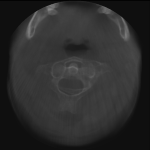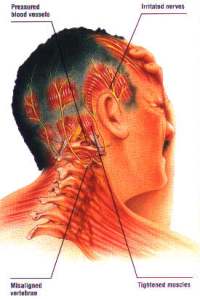Archive
Induced Spinal Cord Compression in Mice
While there have been several pro-chiropractic studies demonstrating the effects of a spinal cord compression, this is a in-lab study done on mice. I am not in favor with animal testing, however this topic is so intriguing that I couldn’t pass it up. The study was designed to essentially observe the cellular effect of a chronic spinal cord compression. To a chiropractor, it is easy to understand that spinal cord compression could be caused by a misaligned vertebra, but in this study they used a artificial calcified mass that continued to grow as the mice matured. The damaged that was caused by the compression was measured by the tissue response. You might want to catch up on your histology before reading the original.
It is also a nice coincidence that the location they decided to compress the spinal cord was at the C1-C2 region. We should all understand that the body has an intelligence that governs every function. Our body responds to the stresses it receives and compensates accordingly. For the most part, our body processes the stress and regains homeostasis. When there is a compressive force interfering with the communication in our body, it starts to break down. This may include a decreased cellular function or hypersensitivity to stress. As the compression continues to exist, the rest of the body begins to suffer from the decreased communication and compensations occur in various regions. The article demonstrates this breakdown in scientific terms and at the site of compression on a cellular level.
- Chronic, compressive subluxations prevent the body from being “well”.
- This image may demonstrate more clearly how the two vertebrae are misaligned.
- Complex anatomy of the upper cervical spine. (Image by Danny Quirk)
Cervical compressive myelopathy, e.g. due to spondylosis or ossification of the posterior longitudinal ligament is a common cause of spinal cord dysfunction. Although human pathological studies have reported neuronal loss and demyelination in the chronically compressed spinal cord, little is known about the mechanisms involved. In particular, the neuroinflammatory processes that are thought to underlie the condition are poorly understood.
I would certainly add “subluxation” to this list of common obstructions to the spinal cord. As for a correction of this compressive force, the article recommended “The only treatment available at present is the surgical removal of the cause of chronic spinal cord compression.” I agree, in part. Remove the interference and restore proper communication and function to the brain and body. In the case of a large calcified mass compressing on the cord, you might need the extreme option. It is much more likely that a misaligned bone may be causing the compression and can be removed by a skilled upper cervical doctor.
If this interest you, read the article. This study was not written by or for chiropractors, however the findings are relevant to chiropractic principles that every effect has an cause, that there can exist an interference caused by subluxation (compression on spinal cord by misaligned vertebrae), and this will cause dis-ease within the body.
References:
- Takayuki et al. The Prevalence and Phenotype of Activated Microglia/Macrophages within the Spinal Cord of the Hyperostotic Mouse (twy/twy) Changes in Response to Chronic Progressive Spinal Cord Compression: Implications for Human Cervical Compressive Myelopathy Published online 2013 May 24.
- Takamatsu R. et al. A Case of Delayed Myelopathy Caused by Atlantoaxial Subluxation without Fracture Published online 2013 April 2.
Arnold-Chiari I Malformation

The yellow arrow indicates the herniated tonsil. This part should stay above the horizontal yellow line.
Chiari I Malformation (CMI) is a condition in which the cerebellar tonsils sink down from the cerebellum into the foramen magnum. This may affect various functions. First, this area of the body (the brainstem) is very sensitive and crowded. The sagging of the tonsils can compress these sensitive tissues or otherwise take up space impeding their function. Additionally there is a nutrient rich fluid, Cerebral Spinal Fluid (CSF), which flows out of the ventricles and baths the brain and spinal cord. As there is not blood circulating the inner brain and spinal cord, CSF provides nutrients to this area. As these tonsils start to droop or sag, they stop up the fluid like a cork in a wine bottle. This decrease in CSF movement to the rest of the spinal canal may also keep the spinal cord from receiving sufficient nutrients giving rise to a variety of symptoms.
From the abstract of one article, “The diagnosis and management of Chiari I malformations (CMI) remains controversial, particularly since it is often an incidental finding on cervical MR scans performed for neck pain and/or headaches.”
Because the cerebellum is in the cranial vault, traditional treatment options have been few and extremely invasive. The goal of surgical interventions, as the article states, is to “restore normal CSF flow dynamics at the craniocervical junction, and hence, decrease the signs and symptoms attributed to CMI”. The goal is spot-on, but the methods are risky at best.
One treatment commonly employed is a craniectomy. This is a removal of part of the patients skull in an attempt to reroute the fluid. Another procedure is to remove the posterior portion of the first two vertebra allowing the CSF to detour around the herniated tonsils.
“Posterior fossa decompression surgery is performed on adults with [Chiari I Malformation] to create more space for the cerebellum and to relieve pressure on the spinal column. Surgery involves making an incision at the back of the head and removing a small portion of the bottom of the skull and sometimes part of the spinal column to correct the irregular bony structure. The neurosurgeon may use a procedure called electrocautery to shrink the cerebellar tonsils. This surgical technique involves destroying tissue with high-frequency electrical currents.”
Wow! I thought cave men were barbaric when they were said to have bored holes in their heads to relieve pressure. This goes one step further by literally frying or cauterizing tissue. We are talking about a persons brain! Unfortunately, essential anatomy is overlooked in favor of attempting to bypass the problem, and in the process, creating new ones. The skull is protecting the brain. How many times have you hit the back of your head? Simple put, you need your skull.
There is an alternative way to manage this “irregular bony structure”. A traditional chiropractic manipulation of the neck is not advised. A Chiari Malformation is contraindicated for general chiropractic and could lead to serious injury. However, a specific chiropractor that has training beyond normal curriculum in the upper cervical spine may be able to help. This chiropractor will complete a thorough exam and take appropriate imaging of the neck, in addition to the imaging that may have already been taken. If there is any twisting or cracking of the neck, you know you’re not in the right place.
An upper cervical chiropractor understands the relationship of the various structures surrounding the upper cervical spine. This doctor can accurately analyze and correct the misalignment of the first vertebra with a light maneuver. Some upper cervical chiropractors use an instrument to align this vertebra. The additional imaging is to see exactly how the vertebrae are misaligned. This is essential to know before any correction is to be performed.
As the structures of the upper cervical spine are put into proper alignment, the mechanical plug of the cerebellar tonsils may release and relieve the area of pressure. The body will then begin to heal and respond positively so long as the correct alignment is maintained.
Additional Resources
Smith, JL. Effects of upper cervical subluxation concomitant with a mild Arnold-Chiari malformation: a case study. Chiropractic Research Journal, 1997;4(2):77-81
Baisden J. Controversies in Chiari I malformations. Surgical Neurology International 2012; 3:232-7.
York, Craig. Video: Chiari 0 Case Study. Orthospinology.org, June 2011
A Case For Improved Headache Evaluation
Headaches, in general terms, lie on a spectrum from an occasional annoyance to debilitating and causing loss time at work and enjoying family. Headaches come in all shapes and sizes and so do the treatments. There have been studies demonstrating the effectiveness of many types of treatments.
First off, we need to agree that a normal headache does not exist. Headaches are alarms telling you that something is amiss in your body. This could be as subtle as not drinking enough water to experiencing a stroke. If you have headaches, even if they are just occasional, understand that this is not a normal function of the body.
In the study published in the “Headache: The Journal of Head and Face Pain” on chronic headache due to hypertonic muscles that attach to the dura matter, a surgical intervention was performed to sever the muscles from the spinal cord. The article explains a normally occurring muscle in the sub-occipital region attaches to the spinal cord. The patient, 35 year old male, had a traumatic incident and subsequent tightness of this muscle putting tension and distortion on the spinal cord/brainstem and causing symptoms of a headache. It was noted that since the incident, the patient had developed a poor immune response as evidenced by the frequency of respiratory and intestinal infection.
The intervention was to surgically sever the tight muscle in hopes that this would relieve the tension and torsion on the spinal cord/brainstem and decrease the severity of the headaches. While the intervention was successful in the sense that the muscle was severed and the patient recovered from surgery, the headaches lessened only in intensity, not in frequency. Common side effects of such procedures are described as “post operative headaches”.
The patient’s complaint persists and is a failure on the part of the exam doctor to understand the anatomy and the mechanics involved. The other attachments of this muscle are on the back of the skull and the first bone in the neck – Atlas. It is very probable and likely that during the traumatic incident that the Atlas became misaligned and torqued, a condition called an upper cervical subluxation, pulling on the muscle and various other structures causing distortion of the spinal cord/brainstem. This is evidenced by several features common in an upper cervical subluxation: sudden onset of headaches following a traumatic incident, tight sub-occipital muscles due to misalignment of bone structures, decreased immune response owed to reduced communication of the brain to the body.
This is further demonstrated by a failure to only partially reduce the symptoms of a headache. The procedure eliminated one instigating agent but did not address the various other factors of an upper cervical subluxation, so the patient would not be able to fully heal. There is so much happening at this location with skeletal, ligamentous and muscular tissue not to mention the nervous tissue that carries body intelligence to every part of your body. An appropriate evaluation of this area is essential to proper treatment of upper cervical subluxation for the best patient care.
Effective upper cervical care can be accomplished and thousands of patients have been helped by removing the causative agent of many types of headaches. This is done without exposing the patient to chemical drugs, surgery, or other lengthy procedures. Not only do the symptoms subside, the effect is realized throughout the entire body improving the immense response and decreasing blood pressure in many cases. Headaches do not need to interfere with your quality of life. Check out the links on the right for other research and testimonies of patients with headaches and become informed of your treatment options.
Another popular management option that does not address the cause of the symptoms is medication. Medication may silence the symptoms, but the inciting problem persists and you can expect the symptoms to return. The liver and kidneys take the brunt of the effects of the medication and there are almost always negative events in response to these chemicals.
Again there is no such thing as a normal headache. Turning off the alarm without addressing the fire will only result in ashes.










